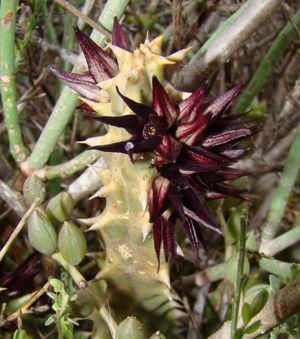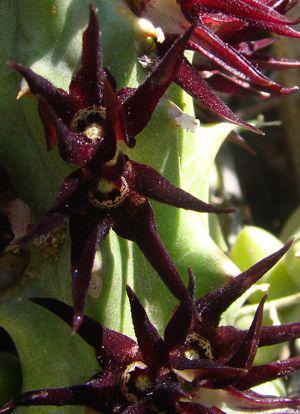Quaqua mammilaris
Quaqua mammilaris (L.) Bruyns
Family: Apocynaceae
Common names: aroena (Afr.); aroena, oruna (Khoi)
Introduction
Aroena makes an interesting addition to any dry veld-food garden.

Description
Description
Quaqua mammilaris is a leafless, succulent shrublet that usually branches from the base to form dense, upright clusters. This spiny succulent has short stems that are 4- or 5-angled, bearing hardened tubercles with sharp, yellow-brown tips. The tubercles are irregularly arranged on the stem and the stem sap is clear. The plant grows up to 450–600 mm high and 500 mm wide. Unlike most other stapeliads, it usually roots from the centre of the stem.

The 20–27 mm long flowers are purple-black and appear in clusters of about 15 flowers that might be open simultaneously from March to June. The flowers produce a strong, foul smell. The flowers are mainly found on the upper half of the stem, but can occur on any part of the stem. The centre of the flower is creamy white with purple speckles and inside of the flower is covered with hairs. The fruit consists of a pair of slender horn-like follicles that split open when ripe, to release many pear shaped seeds. The 4–6 mm long seeds have fine hairs attached to them.

Conservation Status
Status
Aroena is currently listed as LC (Least Concern).
Distribution and habitat
Distribution description
Quaqua mammilaris is widespread and is found from the Klinghardt Mountains in Namibia, through the winter rainfall regions of the Northern and Western Cape, as far as Oudtshoorn in the east. It grows in a wide range of habitats, from sandy areas of coastal Namaqualand to stony slopes or clayey soils in the Kirstenbosch National Botanical Garden. Aroena is usually found growing beneath other plants, whereas larger plants might outgrow their host plant. There are two distinct varieties. In the northern parts of the range the plants appear larger with thicker stems, than those found elsewhere.
Derivation of name and historical aspects
History
The genus Quaqua is derived from a Khoi word Qua-qua which is used for a subspecies within this genus and mammilaris is derived from Latin and means ‘with breasts’ or ‘nipple-like structures’, referring to the shape of the tubercles on the stem. Quaqua mammilaris was amongst the first four stapeliads to become known to science and was first collected by Paul Hermann (1646–1695), who visited the Cape in 1672. Currently this genus has 19 species of which the aroena is the most well-known species.
Ecology
Ecology
The flowers of the aroena, like other dark-flowered stapeliads in general, produce a foul smell to attract flies for pollination. The complex flowers are perfectly adapted for fly pollination. The scent is stronger towards the centre of the flower, thus luring the flies to spend more time there. As the fly gets more nectar, its legs or proboscis (mouth part) may get stuck in the guide rail and it needs to pull to free itself, thereby possibly dislodging the entire pollinarium. The fly, not learning from its previous encounter, visits the next flower, taking the pollen with it. After the flower has been fertilized it falls off and the fertilized ovaries are covered by the sepals. The ovary has the ability to remain in this state for a long period before developing the fruit, and can thus wait for suitable conditions to release seeds, over several good flowering years. The seeds have hairy appendances that allow them to be dispersed by wind.

The plant is leafless and photosynthesizes from the green stems. The sharp tubercles and angled stem also protect it from being eaten by animals.
Hybrids are not often found in nature, because of different flowering times. Or in the case of Quaqua pruinosa, that flowers more or less the same time as this species, the flowers emit different scents to attract different fly species, so cross pollination does not take place.
Uses
Use
The aroena has been used by the Khoi-khoin for many generations, and will make a valuable addition to a veld-food garden. The knoblike thorns are removed and the stems are eaten raw, or can be sliced and added to a salad. Two 10 cm lengths are enough to suppress thirst and hunger for a day. More can be eaten in a day, but should not be eaten by pregnant women. It is also used in a vegetable stew called stoof by the Khoi-khoin. In more modern day gourmet dishes, it can also be roasted in the oven and provides an interesting texture to the dish. Eating aroena may also treat peptic ulceration.
Growing Quaqua mammilaris
Grow
Quaqua mammilaris will grow well in a semi shaded to full sun position.
Unlike most other stapeliads, the aroena is very difficult to grow from cuttings and should be propagated by seeds. Sow the seeds soon after ripe, the more time passes before sowing, the lower the germination success will be. Sow the seeds in a sandy loam medium or a mixture of cleaned river sand and compost (ration 2:1) in autumn or spring. Cover the seeds with a thin layer of sand and fine grit. Soak the pot in water mixed with fungicide overnight. Remove the pot out of the water and keep it in a shady, but warm position. Water every 2 to 3 days. The seeds will germinate within 2 weeks.
Transplant the seedlings once they are about 2 cm high. If the plants are transplanted to a pot, the Kirstenbosch Garden places a moth ball in the soil to help to kill soil-born pests. It is important for the soil to dry out before watering. Water plants about once every 2 weeks. They respond well to fertilizers that can be given once a month during the growth season, which is mainly in spring (September to November in the southern hemisphere).
Good companion plants are vygies such as Worcester vygie, Drosanthemum speciosum or Lampranthus haworthii or pelargoniums such as the blomkoolmalva, Pelargonium alternans. In veld-food gardens, other indigenous plants can include the wild rosemary, Eriocephalus ericoides or ghaap, Hoodia gordonii. In our garden they are often found beneath the gombossie, Pteronia paniculata.
Quaqua mammilaris is susceptible to a variety of diseases. The most serious pest is the woolly aphid (Erisoma lanigerum), that will suck juices of the roots, and can cause secondary infections. It is best to regularly scratch with your finger next to the stem; if woolly aphid is present you will notice the cotton wool threats. Use a systemic insecticide to treat it.
Another disease is the black rot, a fungal disease which creates black spots on the stem. The best method is to use a clean knife to cut away the affected area and then dust the area with flower of sulphur. The affected material must be burned immediately. By adding fungicide to the water after sowing or by spraying fungicide on the seedlings afterwards, will prevent damping-off. Abnormal growth can also be caused by a mite and can be treated by drenching the whole plant in a systemic insecticide.
References
- Bruyns, P.V. 1983. Resurrection of Quaqua N.E. Brown with a critical review of the species. Bradleya 1/1983: 63–65.
- Bruyns, P.V. 2005a. Stapeliads of southern Africa and Madagascar, Volume I. Umdaus press, Hatfield, Pretoria.
- Bruyns, P.V. 2005a. Stapeliads of southern Africa and Madagascar, Volume I. Umdaus press, Hatfield, Pretoria.
- Coetzee, R. 2015. A feast from nature. Penstock publications, Hermanus.
- Goldblatt, P. & Manning, J. 2000. Cape Plants. A conspectus of the Cape flora of South Africa. Strelitzia 9. National Botanical Institute, Pretoria & Missouri Botanical Garden, Missouri.
- Kesting, D. & Clarke, H. 2011. Botanical names: what they mean. Flora documentation programme, Muizenberg
- Van Wyk, B.-E. & Gericke, N. 2000. People's plants . Briza Publications, Pretoria.
- Vlok, J. & Schutte-Vlok, A. 2010. Plants of the Klein Karoo. Umdaus Press, Hatfield, Pretoria.
Credits
Lize Wolfaardt
Karoo Desert National Botanical Garden
October 2015
Plant Attributes:
Plant Type: Succulent
SA Distribution: Northern Cape, Western Cape
Soil type: Sandy, Clay
Flowering season: Autumn
PH: Acid, Neutral
Flower colour: Black, Purple
Aspect: Full Sun, Morning Sun (Semi Shade), Afternoon Sun (Semi Shade)
Gardening skill: Average
Special Features:
Horticultural zones









Rate this article
Article well written and informative
Rate this plant
Is this an interesting plant?
Login to add your Comment
Back to topNot registered yet? Click here to register.